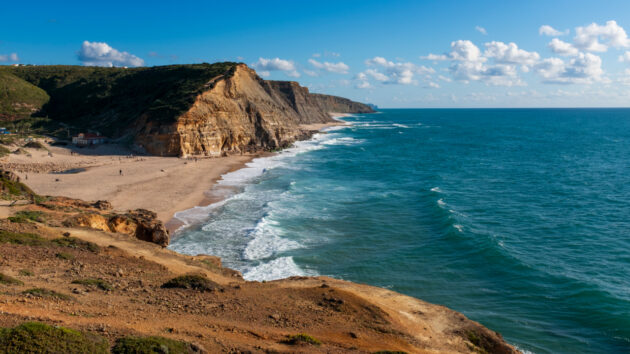
There is really no answer to the question. The truth is, though they are very different, Porto and Lisbon have one major thing in common: They’re both absolutely lovely.
Lisbon
The capital of Portugal, the city of seven hills, Lisbon boasts a rich and diverse culture, with a wide-ranging artistic offer and a variety of theatres, museums, parks and very interesting leisure activities. It is also an international city, the seventh most visited in Southern Europe, probably thanks to its Mediterranean climate.
In Lisbon you’ll find the perfect blend of past and future, classical and modern. Life is more expensive here than in Porto, but the light and sunshine are unique.
Porto
Around 300km north of Lisbon, Porto’s climate is more pronounced, with cold and rainy winters and a warm and dry summer. Famous for its historical centre, cuisine and wine, it is a perfect city for walking.
The simplest stroll could turn into an adventure, discovering heritage, people and traditions, perhaps even more so than in Lisbon. Listening to the heavier Porto accent as you meander through the streets or do your shopping can, in the right circumstances, be enough to leave you in a good mood for the rest of the day.
Porto is a safe city and boasts exuberant views and a great quality of life, which more than make up for the cold and damp winter climate.
Porto or Lisbon: the differences
The views

Both cities were founded on hills that overlook rivers, so you can imagine the fantastic views you can get. And they are indeed! It is actually quite hard to choose the nicest ones.
Lisbon has several belvederes, starting with the Portas do Sol, in Alfama, from where you can get spectacular views over the tiled roofs that make their way down to the Tagus. The terrace in front of the Graça Church overlooks a great deal of the historic centre, all the way to São Pedro de Alcântara.
The highlight in Porto tends to be the belvedere of Nossa Senhora do Pilar, with its surprisingly impressive view over the river, the buildings in the Ribeira district and the surrounding city. The climb up the Clérigos Tower, which is 76 meters high, is also an unforgettable experience.
The Douro and the Tagus
Porto and Lisbon were built overlooking mighty rivers that make their way from Spain to the Atlantic. The Tagus bathes the capital, forming one of the largest estuaries in Europe, where you can see a variety of wildlife, including the occasional dolphin or flamingo.
Porto rises on the banks of the Douro, with its eyes set on the traditional rabelo boats that were used to transport barrels from the wineries but today are mostly used for entertainment.
Tripeiros and alfacinhas
Residents of Porto are known as “tripeiros” and those of Lisbon as “alfacinhas”. According to the legend, in 1415, when King John I set out for Ceuta to begin what would become the colonial expansion, the inhabitants of Porto played a major role.
Besides being very much involved in the building of the ships, they also supplied the fleet with whatever food they had, mainly meat which, after being cleaned, was salted and stored in the vessels. This left the city almost bereft of supplies, other than the offal, such as tripe, which they quickly learned to cook and went on to become a traditional dish in the region.
In Lisbon it is believed that the “alfacinhas”, or “little lettuces” nickname comes from the large amounts of lettuce that grew on the hills that make up the city, and that at the time were used not only for food, but also for making perfumes and medicines. Another version says that it was coined by the inhabitants of the surrounding regions, tired of being called saloios, which could be rendered as hillbillies.
On seeing the people of Lisbon in their fancy Sunday best and frilly collars, they remarked that it looked like they had lettuces around their necks, and the name stuck until today.
The neighbourhoods
Lisbon is often called a “city of neighbourhoods”, but here the term goes beyond just a subdivision of the city and means more of a communion of ties that bind together the residents, as if they were a family. In the capital there are several popular neighbourhoods such as the Bairro Alto, Graça and Mouraria, but the most iconic of all is definitely Alfama, where the traditional Fado music has its roots. Sculpted mostly out of limestone its houses stand out for their pastel colours, which hark back to medieval times.
In Porto the main neighbourhoods are the Baixa – downtown, as well as Cedofeita, Massarelos or Boavista. But the most traditional of all is the Ribeira, right on the riverbank. Unlike Alfama in Lisbon, though, here most of the houses are granite grey and convey a more sombre tone, with many of the façades covered in traditional tiles.
Due to the international reputation it has recently gained, Alfama is one step ahead of the competition in terms of popularity, as can be seen by the crowds of curious tourists and souvenir shops that have pushed out the more typical grocery stores. The Ribeira, on the other hand, has preserved more of its ancestral DNA, such as the taverns that remain and help perpetuate the traditions of the northern folk.
Which beaches?
Both Lisbon and Porto benefit from being close to the Atlantic and, therefore, are blessed with beautiful beaches. Down south there is always the Costa da Caparica, which can be reached in around thirty minutes, provided you avoid rush hour, but a bit further out there is also the Arrábida coast, right after the Sesimbra and Meco beaches.
If you don’t want to cross the Tejo you can also try the beaches along the Cascais coast, which are calmer in the Summer, and which give way to the rougher Guincho and Praia Grande beaches, the latter already in Sintra, or Ericeira, just a little further North.
As for Porto, it is built right on the mouth of the river and has some of the best urban beaches in the country. This neighbourhood, Foz, is itself one of the poshest parts of the city. South of the Douro you’ll find Espinho, with a 15km stretch of excellent beaches. The main difference between the two cities is water temperature, which is considerably colder up north.
Beer: Imperial or fino?

It isn’t only the accents that vary between Porto and Lisbon – with the more harmonious northern tone and the habit of swallowing syllables in the capital – there are also specific terms that are only used in one city or the other. If you want a draught beer in Lisbon you ask for an “imperial”, but that word will get you no more than blank stares or sarcastic looks in Porto, where you need to order a “fino”.
There are also the classical stereotypes, with the northerners claiming to work harder than those in the capital and, of course, there is room for the traditional football rivalries between Futebol Clube do Porto and Benfica and Sporting, that can often be excessive.
Port or ginjinha?
No matter how pleasant a trip down to the Rossio, in the centre of Lisbon, to try a ginginha, the sweet liqueur made from sour cherries, it hardly compares to a visit to the old Port Wine cellars to try the drink that has long been a favourite amongst aristocracy, from London to Moscow, and connoisseurs from all over the world.
The best cafés
Whether you call it a cimbalino, as they do in Porto, or a bica, the preferred term in Lisbon, both cities have excellent and famous cafés where you can go to enjoy your coffee. Are the most traditional, elegant and charismatic cafés in Lisbon or in Porto?
The truth is that both cities have solid claims. Porto has the famous art deco Café Guarany, founded in 1933 and regarded as the musician’s café, and you won’t want to miss out on the charismatic Majestic, a classical belle epoque style café that continues to be a reference in the city.
In Lisbon you’ll find the Confeitaria Nacional, founded in 1829, the Brasileira, in the Chiado district and the Versailles in the more modern Saldanha area. The Chiado also boasts the Bénard. All wonderful spots to go for a tea or coffee with a large serving of tradition.



